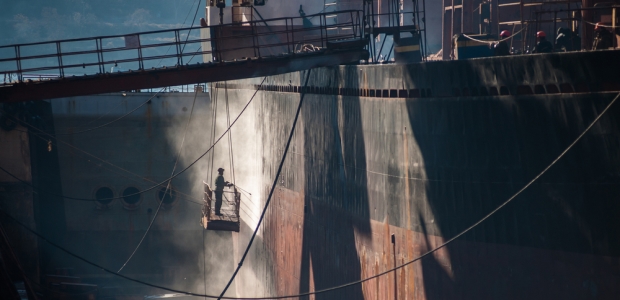
OSHA Wants Input on Shipyard Fall Protection Rules
Falls are a leading cause of shipyard fatalities, according to OSHA, which states that 40 percent of all fatal incidents in shipyard employment from 1992 to 2014 resulted from falls to a lower level, citing BLS data. The current standards haven't been updated since 1971.
OSHA is requesting input from the maritime industry, issuing a Request for Information as it considers updating Subpart E of the Occupational Safety and Health Standards in Shipyard Employment -- the standards addressing falls in shipbuilding, ship repair, shipbreaking, and other shipyard-related employment.
The request seeks comments and information on safe access to and egress from vessels, buildings, and other structures in shipyards (including the use of stairways and ladders); the use of fall protection and also falling object protection; and the erection, use, and dismantling of scaffolding systems. Comments and materials may be submitted electronically to www.regulations.gov (search for Docket No. OSHA-2013-0022). They are due by Dec. 7, 2016.
Falls are a leading cause of shipyard fatalities, according to OSHA, which states that 40 percent of all fatal incidents in shipyard employment from 1992 to 2014 resulted from falls to a lower level, citing BLS data. The current standards haven't been updated since 1971.
The request lists three reasons why the agency wants to update this section of its regulations:
- "First, workplace slips, trips and falls, particularly falls to a lower level, continue to be a major cause of worker fatalities and injuries in shipyard employment. Bureau of Labor Statistics (BLS) Census of Fatal Occupational Injuries data from 1992-2014 indicate that on average 40 percent of all fatal occupational incidents in shipyard employment resulted from falls to a lower level. Also, OSHA Integrated Management Information System (IMIS) data indicate 32 falls resulting in death or hospitalization occurred in shipbuilding and ship repair between 2002 and 2014. Of those falls, 24 (80%) resulted in a fatality. The IMIS data shows the falls were from various workplace surfaces, including scaffolds, ladders, stairways, platforms, drydocks, and ship decks. OSHA also notes that nine struck by falling object injuries occurred in shipyard employment during that same period, seven (78%) of which resulted in death. According to BLS occupational injury data from 2003-2013, an average of 642 slip, trip and fall injuries involving days away from work (DAFW) occurred annually in shipyard employment. This accounts for approximately 22 percent of all DAFW injuries in this industry. Slips, trips and falls are the third leading cause of DAFW injuries in
shipyard employment, behind overexertion and contact with equipment.
- "Second, the standards in subpart E are not comprehensive in their coverage of slip, trip and fall hazards in shipyard employment and are supplemented by applicable general industry standards (29 CFR part 1910, subparts D, E and I) to fill the gaps in subpart E's coverage of those hazards (29 CFR 1910.5(c)(2)). [Here, the agency notes that construction standards apply when shipyard workers perform construction activities.] However, this approach requires that shipyard employers look in both parts 1915 and 1910 to find the standards on fall and falling object protection, scaffolding and access/egress that apply to shipyard employment. Stakeholders in shipyard employment and MACOSH have urged OSHA repeatedly to consolidate all standards applicable to shipyard employment into part 1915 so they only have to follow one set of standards.
- "Third, the standards in subpart E are outdated and do not reflect advances in technology or industry best practices developed since OSHA adopted subpart E. Comments received from the U.S. Navy and MACOSH members . . . as well as other stakeholders, expressed similar issues with subpart E and its need for revision."
The agency is asking for comments about revising and updating shipyard employment standards that address slip, trip and fall hazards; increasing consistency in the shipyard employment, general industry and construction standards that address fall and falling object protection, scaffolding and access/egress; identifying technological advances, industry best practices, and outdated provisions; consolidating general industry standards into part 1915;
and reorganizing subpart E standards into three subparts (subparts E, M, and N).